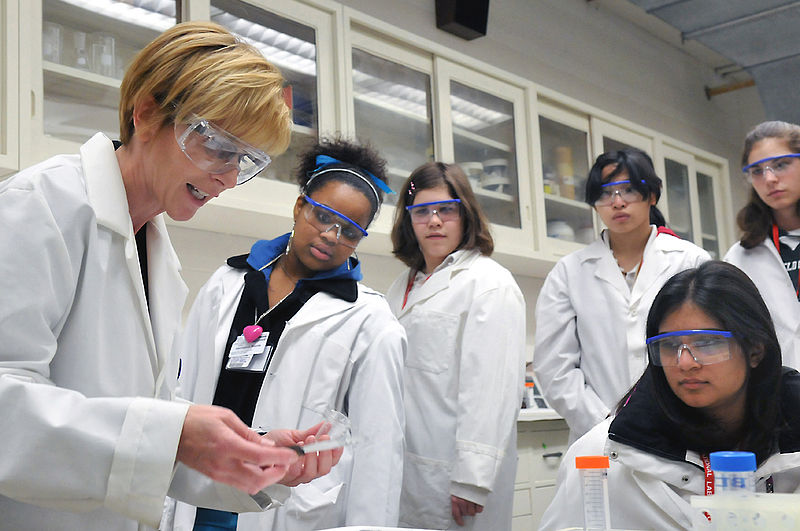In 2014, many of the top tech companies released information on their employee diversity demographics for the first time, bringing attention to the low representation of women in top tech companies. This post looks beyond these numbers. How are tech companies responding to this gender imbalance?
The top five tech companies by market cap are, in order: Apple, Alphabet (Google), Microsoft, Amazon, and Facebook. The gender balance of each company’s workforce is in the table below:

All of these companies are seeking to improve their gender balance and support current women employees. Resource groups, family benefits and smart hiring practices are some of the most common solutions. Even when these efforts are made, the male-dominated work environments can be far from ideal for women at these companies.
Women Employee Experiences
Resource Groups
Resource groups can serve as valuable support networks for women employees. Each of the top tech five has at least one employee resource group for women (Apple: Women@Apple; Google: Women@Google, Google Women in Engineering; Microsoft: Women@Microsoft; Facebook: Women@Facebook, Amazon: Women@Amazon, Amazon Women in Engineering, Women in Finance Initiative). All of these groups share similar goals: empowering women in their workforce and providing networking opportunities.
Many of these resource groups also participate in community outreach, engaging young girls and women and creating programs to foster their interests in technology. (See Women in STEM: Closing the Gap for more information on how community outreach can help change the culture around women in STEM in the United States.) After recognizing that underrepresentation of women in tech is related to the lack of educational STEM exposure and encouragement for women, Facebook created Computer Science and Engineering Lean-In Circles to support women in college who are interested in CS.
Conferences
Sponsoring women’s tech conferences, like the Grace Hopper Celebration of Women in Computing or the Women in Real Life (WiRL) Conference, is also common among these resource groups. Amazon even holds its own conference: Every year, the women’s resource groups at Amazon also team up to host AmazeCon, a diversity conference that focuses on the achievements due to diverse teams at Amazon. The conference draws thousands of experts and leaders to discuss the importance of diversity in creativity and accomplishments.
Microsoft has taken an extra step by creating an innovative program for women, Women Think Next. WTN is a “worldwide community for professional women,” bringing together women from varying fields and backgrounds to network and support one another.
The program is not limited to Microsoft employees. WTN encouraged any and all professional women around the world to join. Women Think Next holds an annual networking conference and provides resources for women throughout the year. The conference also serves as a recruitment event for Microsoft to hire women with strong skills.
Employee Complaints
Everything isn’t always as it seems on paper, though. The male-dominated work environments at these companies can be isolating for female workers. In 2015, Microsoft faced a lawsuit accusing the company of gender-discriminatory policies in employee reviews. In May 2016, a former Facebook contractor published a piece on the sexism she experienced while working on a project team. During September 2016, Apple received criticism in the media for a series of leaked emails that revealed the company’s unresponsiveness to concerns of women employees. Through these emails, women employees described the company’s atmosphere as “toxic,” including workplace harassment and gender discrimination.
It is important to note that these are all anecdotal experiences. Each company responded by emphasizing that they take complaints like these seriously. The sensitive nature of the companies’ investigations of these claims prevents more information from being public.
Work-Life Balance
In American society, women often face conflict between the gender norms surrounding women’s family responsibilities and a desire to pursue a career. Maternity and family leave benefits can be an important factor in a woman’s decision to stay with a company in the long run, especially after she has started a family.
Of all of the Organization of Economic Cooperation and Development member countries, the United States is the only one that does not mandate paid maternity leave. According to the most recent statistics, only 12% of Americans receive this benefit.
However, within the tech top five, they seem to go far and beyond this requirement. Below is a summary of the family leave benefits for the tech top five.

It is not surprising that these companies give generous benefits. Named the best place to work in the U.S. in 2015 by both Forbes and Glassdoor, Google is known for its employee perks. One of Google’s greatest strengths lies in its emphasis on self-study to determine workforce problems and find solutions. In 2007, Google’s People Operations (AKA Human Resources) department noticed that new mothers left Google at twice the average departure rate. In response, the company decided to lengthen paid maternity leave from 12 to 18 weeks. After this change, Google’s departure rate for new mothers dropped by 50 percent.
Controversial Benefits
In 2014, both Apple and Facebook received media attention for their announcements that they would pay to freeze U.S.-based employees’ eggs. Apple announced it as a new dimension to their support for infertility treatments. The move was met with mixed reviews by the media. NBC News praised it as a “game-changing perk,” but The Guardian denounced it as “unreasonable and illogical.” Supporters of the policy argue that it gives female employees more flexibility in their decision to have children. Critics claim that the policy sends the wrong message, implying that if female employees want to succeed at work, they need to delay motherhood.
Parental Equality
It is important to look not only at a company’s maternity leave policies, but at their parental and family leave policies as well. Studies of maternity and motherhood-related policies in other countries, like a mandated child care law in Chile and a reduced hours law in Spain, have shown that offering parental benefits only to women can lead to a decrease in salary and promotion rates of all women at a company, even those who don’t take advantage of them. One approach to combating these negative effects could be making these policies gender-neutral. This would allow for men to take advantage of these policies and reduce gender-discriminatory practices.
Hiring, Promotions and Pay
Facebook has received attention for its hiring point system. Facebook’s recruiters receive points for new hires, but based on the new recruits’ diversity, it can earn recruiters more points. White or Asian males only count for one point, whereas black, Hispanic, or female new hires count for two points. Higher point totals can lead to good performance reviews and bonuses for recruiters. This system incentivizes the creation of a more diverse workforce.
At Google, employee studies showed that women were less likely than men to submit their names for promotions. After Google brought this information to the attention of women employees, this discrepancy disappeared. Google now prides itself in the fact that they promote women and men at the same rates.
In August 2016, Apple announced plans to increase hiring of women and minorities. During the same announcement, they celebrated their official elimination of all gender pay gaps within the company. To maintain this, they have pledged to analyze and correct any gaps as they may arise in the future.
Amazon has also addressed its pay gap. Amazon boasts that women earn 99.9 percent of men’s salaries, explaining that the percentage fluctuates annually, so that it may not always reach a perfect 100 percent. However, Amazon has received criticism on its diversity reports for not including statistics on the percentage of women who make up their tech workforce. This discrepancy has led media to question whether Amazon has something to hide. Until Amazon releases more information, there is no way to know the state of female representation in their tech workforce.
What Does This Mean?
When compared to national averages, women are not as well-represented in the top tech companies. However, these companies provide benefits and services to their women and employees that are above and beyond the norm. Nonetheless, as the anecdotal experiences of the women at Apple, Facebook, and Microsoft have shown, a company can offer great benefits while still tolerating a discriminatory workplace environment.
Regardless, these companies need to develop new strategies to address low women’s representation. Only time will tell how future policy, research, and incentives will impact women’s employment in the tech workforce.













 vement, behind the United States.
vement, behind the United States.